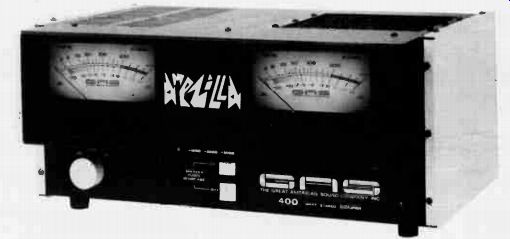
Ampzilla as we built and tested it. As currently supplied it has a pushbutton on/off switch and a more restrained logo.
Ampzilla A Monster with a Silken Touch
The Equipment: Ampzilla stereo power amplifier with output- level meters for both channels, in metal case. Dimensions: 17 1/2 by 7 by 9 inches, plus clearance for connections. Price: $799. Warranty: five years parts and labor. Manufacturer: The Great American Sound Co., Inc., 8780 Shoreham Dr., West Hollywood, Calif. 90069.
Comment: Some of us may have become just a bit jaded in dealing with the subject of super-amps and their capabilities, so we will begin this report, perhaps naively, by noting that the rated power output of Ampzilla (400 watts total with both channels operating) is in excess of one-half horsepower, enough to run most washing machines. Of course, this is not an unusual power capability for a super amp, but it is an awful lot of power, just the same.
The allusion to driving an electric motor with an amplifier is not really facetious, for loudspeakers are just that- motors. And they are not particularly efficient either. Add to this the fact that each doubling of the subjective level of a reproduced sound requires a tenfold ( 10- dB) increase in power, and it becomes clear that 200 watts per channel--far from being wasteful and ridiculous excess--at times may be indispensable.
Ampzilla surely cannot be described as your basic shy, retiring stereo component, ready to fit smoothly into every decor. Frankly, it is not even discreet. The front panel virtually leaps forward, dominated by a pair of meters (calibrated for 0 dB at 200 watts and including both scales) with the aggressively stylized name inscription between them. Below these and at the left is a pushbutton (push on, push off) that controls the AC power to the amplifier and switches the cooling fan. Toward the center of the panel is a switch that increases the sensitivity of the meters for full-scale deflection at 0, - 10, - 20, or -30 dB (200, 20, 2, or 0.2 watts). The holders for the loudspeaker fuses (a necessity with an amplifier such as this) are stacked vertically just below the aforementioned switch and are flanked on the right by the manufacturer's logo.
------------------
REPORT POLICY: Equipment reports are based on laboratory measurements and controlled listening tests Unless otherwise noted, test data and measurements are obtained by CBS Technology Center. Stamford. Connecticut. a division or Columbia Broadcasting System, Inc , one of the nation's leading research organizations. The choice or equipment to be tested rests veal the editors of High Fidelity., Manufacturers are not permitted to read reports in advance of publication, and no report, or portion thereof may be reproduced for any purpose or in any form without written permission of the Publisher. All reports should be construed as applying to the specific samples tested. Neither High FIDELITY nor CBS Technology Center assumes responsibility for product performance or quality.
-----------------
The back panel, by contrast, is simplicity itself, bearing only pin-jack input connections, binding posts ( accepting bare wires or spade lugs) for loudspeaker connections, a power-line fuse, and a hefty AC- power cord of the three prong grounding variety. This is a massive unit ( it weighs about 45 pounds), and it gives an impression of great ruggedness. The ventilation chimney for the output- stage heat sinks is large and provided with a cooling fan de signed to protect the unit when subject to severe use or high ambient temperatures.
The sample of Ampzilla that we had tested by the CBS Technology Center was built from a kit, a form in which unfortunately for do-it-yourself enthusiasts--it is no longer made. (You may still find kits at some dealers if you hurry.) Though the kit was somewhat difficult to assemble, its performance sets a high standard for factory-assembled units.
Trying to drive this amplifier into audible distortion is simply a waste of time. Something always intervenes first- the protection circuitry, if the amp is driven grossly beyond its ratings or, more likely, distress signals from one's ears or the loudspeakers. Distortion specifications (which are unusually rigorous at 0.05% THD or IM for full power or below into 8 ohms, 20 Hz to 20 kHz) were met handily with two almost insignificant exceptions: THD for 2 watts ( 1 % of full power) at 10 kHz and above ( where 0.1% was the highest distortion recorded) and full-power IM at 8 ohms (where the excess is a minuscule 0.013%). Power bandwidth for 0.5% THD was checked only at 1 kHz as this is strictly an "abuse" condition that drives Ampzilla considerably beyond its clipping point.
As far as our own listening tests are concerned. Ampzilla just isn't there--it seems to have no effect whatever on program material passing through it. While this cannot be literally true, the lab data insists that it very nearly is.
Rather than waste time in trying to describe the indescribable, in trying to delineate near absence of coloration, we will let the lab data speak for itself. The unit is, of course, not cheap. But, considering its outstanding performance, its price seems very reasonable. If you are in the market for a monster power amplifier, you would do well to consider Ampzilla. It is, in a word, superb.
-----------------
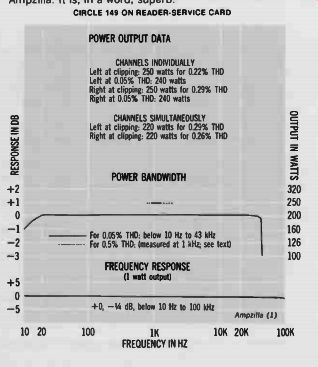
POWER OUTPUT DATA CHANNELS INDIVIDUALLY left at clipping: 250 watts for 0.22% THD Left at 0.05% THD: 240 watts
Right at clipping: 250 watts for 0.29% THD Right at 0.05% THD: 240 watts CHANNELS SIMULTANEOUSLY
Left at clipping: 220 watts for 0.29% THD
Right at clipping: 220 watts for 0.26%
THD POWER BANDWIDTH
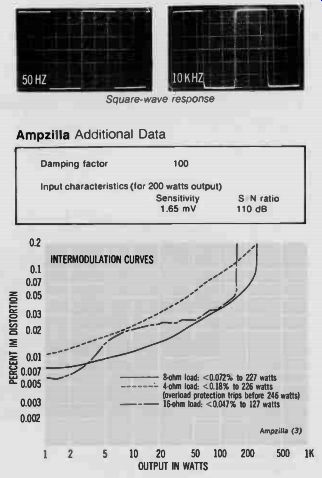
Square- wave response
Ampzilla Additional Data INTERMODULATION CURVES, HARMONIC DISTORTION CURVES
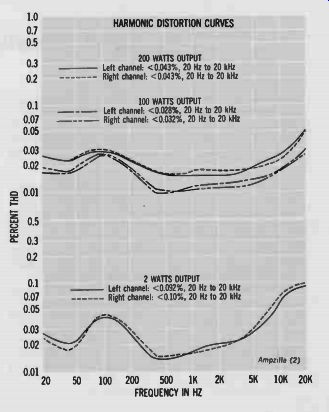
Uher's Most Luxurious Cassette Deck

The Equipment: Uher Model CG-360, a front- loading stereo cassette deck with Dolby B noise reduction and bidirectional playback, in molded high- impact plastic case. Dimensions: 15 3/4 by 4 inches (front); 11 1/2 inches deep plus clearance for controls and connections. Price: $ 1,066.95; optional W-319 amplifier module, $75.50; optional F-113 remote control, $ 110. Warranty: 90 days parts and labor. Manufacturer: Uher Werke München, W. Germany; U.S. distributor: Uher of America, Inc., 621 S. Hindry Ave., Inglewood, Calif. 90301.
Comment: Uher has done it again--come up with a model that is signally unlike any other on the market. The CG 360's personality is luxurious, convenience-conscious, and extremely Continental. Hence it is not a personality that all American recordists will take to immediately, but any cassette-lover owes it to himself to explore it.
The Continental element makes itself known immediately, in the trilingual owner's manual and in the DIN-only connection jacks. The manual makes it quite clear that Uher has little patience with the pin jacks that U.S. audiophiles consider standard. (The unidiomatic English. unfortunately, doesn't make everything else equally clear.) But Uher supplies two DIN- to- pin stereo interconnect cables.
One is used (for recording) from the output pin jacks on your receiver or preamp to the so-called PHONO input at the back of the deck. (This is a 5-pin jack that bears no relationship whatever to the low-level RIAA phono inputs on receivers and preamps.) The other is used ( for playback) be tween the RADIO output (another 5-pin DIN jack, next to the PHONO jack) and the tape- monitor connections of your receiver or whatever. The RADIO connection actually is an input/output jack; the input section goes unused with American systems, because it is too sensitive for the volt ages to be expected from them.
In addition, the back panel has a 6-pin DIN jack marked ACCESS that is intended for sync- pulse use with accessory equipment for slide-film work. (It puts the sync track on what otherwise would be Side B of the tape, leaving both stereo tracks of Side A free for audio.) And there is a multi conductor contact strip for use with the optional F-113 remote control. Next to this strip is a removable panel covering the opening into which the owner can mount . the optional W-319 power amp module, rated at 10 watts per channel into 4 ohms. We did not test either of these options. The power- line socket, fuse, and line-voltage switch complete the back-panel features.
There are three more DIN sockets, with varying pin con figurations, at the left end of the front panel. One is for ear phones, one a RE-RECORDING jack for dubbing between the Uher and another deck, one the stereo microphone input.
The microphone and RE-RECORDING inputs both override the RADIO input; either can be mixed with the PHONO input.
The first two sliders beyond the tandem peak- reading meters are accordingly marked RADIO/MICRO and LINE (which corresponds to the PHONO input). Each of these sliders controls both channels of the stereo signal; a RECORDING BALANCE slider below the meters adjusts the channels with respect to each other.
Another group of sliders toward the middle control BASS, TREBLE, VOLUME, and BALANCE in the headphone and accessory amp circuits only-that is, they do not affect line feeds. Near these sliders is a three-position switch control ling the playback/auto-reversing feature. One position stops play at the end of the cassette side, one stops it only after the second side, one offers continuous repeat play back. At the right is the cassette slot. The cassette is fed in end-first with Side A up and the head opening facing to the left. A lever just below the slot lowers the cassette to playing position and releases it when you're finished. The mechanical design is quite complex and proved balky in one sample we tried, though in working with two samples of the CR-134 (HF test reports, January 1975), which has a similar design, we had no such problem.
The counter is next to the cassette LOWER/EJECT lever.
When a cassette is inside, a light shines up through its window, which can be seen through a small window in the top of the deck above the tape slot. This allows you to check the remaining tape, which some slot- load designs don't. It is the only operating feature on the top panel.
Recessed along the bottom edge of the front panel are the transport controls: a series of concave square push buttons, each with a small pilot lamp-red for recording and green for the remainder. Since this is a bidirectional unit, there are two PLAY buttons, only one of which can be used in recording, of course. The main ON/OFF button is to the right of these controls. Farther to the left, between the two balance sliders, are similar buttons for DOLBY and SEN SITIVITY, the latter adding gain in the RADIO input circuit when it is engaged. These switches, too, have pilot lamps.
That for the Dolby circuit is above the DOLBY button; that for the SENSITIVITY option is near the bottom of the meter window. Above it, along the right side of the meters, are similar pilots for FEO, ( ferric oxide) and CRO, (chromium dioxide)-referring to the bias and equalization needed for these tape types. The setting is made automatically by a sensor in the cassette slot (encountering, or not encountering, the extra " well" at the back of recent chrome cassettes); there is no manual override, so older chrome cassettes (without the well) can't be used successfully on the CG-360. The unit was tested with Maxell UD as the ferric tape (Uher supplied some with the test sample, though the manual remains mum on the question of recommended tapes) and BASF Chromdioxid as the chrome. Response is quite flat with these tapes (as is the DIN playback response) and is notably free of "fringing" effects in the bass, but the range is not particularly extended at the top end. While some cassette decks we have tested will cap ture as much as an extra half-octave in the overtone range at the top of the spectrum, few are as smooth and linear between the frequency extremes--where, of course, most of the musical information lies.
Note that the Uher stays very close to the DIN 0-VU standard in its metering, but since it uses peak-reading meters this does not presuppose the severely overloaded peaks that normally would result from a combination of averaging (" true VU") meters and so high a 0-dB point.
Noise and distortion figures are within the ranges represented by today's better cassette decks, with the harmonic distortion curves approaching the measurement limits imposed by noise. Channel separation figures (at about 20 dB) are much lower than those we've measured on any cassette unit in recent months except Uher's own CR-134; they are not poor enough, however, to threaten audible degradation of the stereo image. This is to say that most cassette decks these days have far more separation than they really need. Speed stability measurements all are very good; wow and flutter are only a hair short of the very best.
All the printed specs, where they allow for direct comparison with the lab data, are met by the unit.
And the deck sounds very good. But in view of several of the CBS measurements on our sample of the CG- 360 we wonder about Uher's claim that this is a " cassette tape recorder with the performance characteristics of high quality open- reel tape equipment." In our view it is, rather, a convenience-oriented deck that will ease the path to good sounding recordings and automatic continuous playback for the user who doesn't want to fuss with equalization switches or cassette flippings. It is easiest to integrate into DIN-oriented systems, and American recordists may find themselves fussing with cable adapters-for the microphone and headphone circuits particularly- unless they spring for Uher accessories as well. But, within its unique concept of what a cassette deck should be, Uher has shown itself truly inventive. This model fairly bristles with distinctive touches, from the many interlock micro switches of its ingenious transport to well-engineered feel and utility of its solenoid controls.
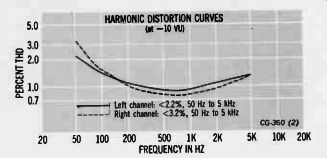
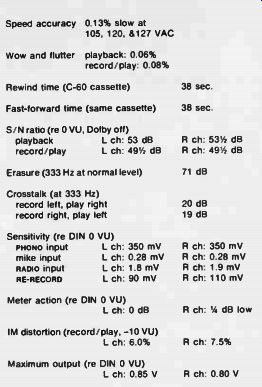

--------- HARMONIC DISTORTION CURVES ; Uher CG-360 Additional Data ; DIN PLAYBACK RESPONSE (0 dB = -20 VU)
Yamaha CR-400: A Spartan Receiver with Class
The Equipment: Yamaha CR- 400, a stereo FM/AM receiver in wood case. Dimensions: 17 1/2 by 6 5/16 inches ( front panel); 11 3/4 inches deep plus allowance for controls and connections. Price: $330. Warranty: five years parts, three years labor; shipping paid one way. Manufacturer: Nippon Gakki Co., Ltd., Japan; U.S. distributor: Yamaha Audio Di vision, P.O. Box 6600, Buena Park, Calif. 90620.
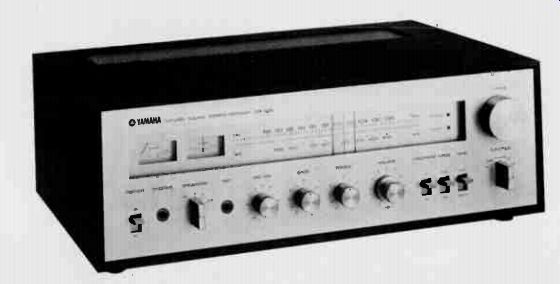
Comment: At first glance the front panel of this receiver seems almost bare, partly because of the very clean styling and partly because of the contrast between its highly reflective brushed aluminum surface and the warm finish of the attractive wood case that houses the unit. But this appearance is deceptive, for a closer look shows that the CR-400 has a well-chosen ( though not luxurious) array of controls and indicators, all of which do their jobs quite well.
Extending across the top half of the panel is a slide- rule tuning dial, flanked at the left by signal- strength and tuning meters and at the right by a hefty tuning knob. Slightly to the left of the knob are indicator lights for FM STEREO and POWER. The lower part of the panel holds ( from left to right) a POWER on/off switch, a stereo headphone output jack, a SPEAKER selector switch (for either or both of two sets of 8- ohm speakers, or off), a phone-type microphone input jack ( mono-feeding both channels), BASS and TREBLE controls, and a VOLUME control with separate, con centric friction-clutched elements for the two channels.
Continuing to the right, one finds switches for LOUDNESS compensation, MODE (stereo/mono), and TAPE MONITOR, followed by a FUNCTION selector (for AUX, PHONO, FM [with] MUTING, FM, or AM. A HI filter might be a welcome addition; the TREBLE control can do stand-in duty here, of course, but its action is broader than one might like.
At the left side of the back panel are the antenna inputs for FM (both 300- and 75-ohm impedances are provided for) and AM. These connections are made via knurled plastic-capped screws that are easy to turn with the fingers.
The eight loudspeaker outputs (for two 8-ohm stereo pairs) are spring-loaded and accept bared-wire leads. Be low the antenna connectors are two neat rows of pin jacks for PHONO, AUX, and TAPE inputs and REC and PREAMP Outputs. Two AC convenience outlets are provided (one of which is controlled by the front- panel POWER switch), each rated to handle 200 watts. In addition, there is a protective fuse at the far right and a centrally mounted rod antenna for AM. In our listening tests we tried everything short of down right abuse to embarrass the rather modestly rated ( 16 watts per channel at 8 ohms) amplifier section-to no avail. The power bandwidth curve suggests that, had Yam aha gone the route of many manufacturers, it might have claimed 20 watts per channel at 0.5% harmonic distortion (some of its ratings are for only 0.1%), from 40 Hz up, if not from 20 Hz. As it is, the amp section in our sample falls slightly short of Yamaha's more- rigorous 0.1% rating point at 20 Hz. This can hardly be accounted a failing since the rating point is so low, since the unit meets the 0.5% rating with room to spare, and since even at 40 Hz-at or below the approximate limit of response for many speakers appropriate for use with the CR-400-the unit is well within the spec. Intermodulation also narrowly fails to meet Yamaha's rigorous 0.1% spec ( at 8 ohms), though it ( like the THD figures) is well below the 0.5% or so more commonly specified for receivers in this price class. The upper end of the power bandwidth is a different story: The -3 dB point is simply beyond our test range; 0 dB is at 100 kHz! The preamp section shows itself a worthy partner, with good sensitivity and excellent signal-to-noise ratios at all inputs. There is some droop in the RIAA equalization for the extreme bass (-4 dB at 20 Hz), but few records have program material at this frequency, and the error helps to counteract turntable rumble.
The FM section is, of course, no match for super-tuners (like Yamaha's own CT-7000), but it is a creditable per former and an apt counterpart to the amplifier section.
Mono quieting exceeds 50 dB for all signal levels above 10 microvolts; stereo quieting reaches 47 dB by 25 microvolts and falls off somewhat after that, reaching 53 dB only at very high levels. Capture ratio is respectable at 2 dB, while alternate-channel selectivity is an astonishing 82 dB. There is no stereo filter or blend control-which might have been nice, though weak stereo stations can be partially de noised by flipping the MODE switch to MONO of course. The 19- kHz pilot tone is not quite as well suppressed here as it is in some tuners and presumably contributes to the slightly high distortion readings at 10 kHz. This is a trouble spot for many tuners, and the CR- 400 actually beats many costlier units in this respect. Frequency response is good in both stereo and mono, and stereo separation is extraordinary for a relatively inexpensive receiver.
------------------
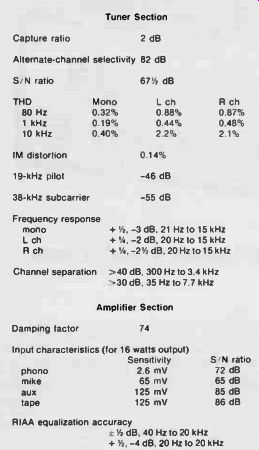
Yamaha CR- 400 Additional Data
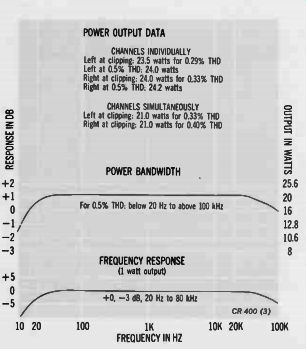
------------------- POWER OUTPUT DATA CHANNELS INDIVIDUALLY Left at clipping:
23.5 watts for 0.29% THD Left at 0.5% THD: 24.0 watts Right at clipping:
24.0 watts for 033% THD Right at 0.5% THD: 24.2 watts CHANNELS SIMULTANEOUSLY
Left at clipping: 21.0 watts for 0.33% THD Right at clipping: 21.0 watts
for 0.40% Tie Square- wave response FM SENSITIVITY & QUIETING CHARACTERISTCS
HARMONIC DISTORTION CURVES

--------- INTERMODULATION CURVES

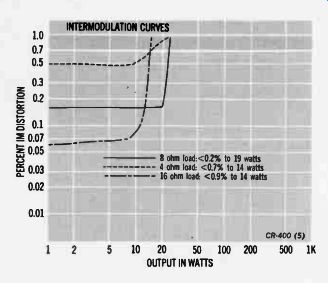
The CR- 400 has tape outputs for disc dubbing and recording off the air, but, if you wish to add announcements via the microphone input, the audio must be taken from the output of the preamp. This is at a point after the tone controls, so these can be used to improve poorly balanced program material. The AM section, an afterthought in many receivers, is a good deal better than one might expect. It proves quite listenable-although it welcomes help from an outdoor antenna.
But a receiver, like any composite, is more than the sum of its parts, and the CR- 400 is no exception. While it is bare of frills ( except, perhaps, the mike input) and cosmetic features, the features that it does have complement each other and work very well. An attractive and fine sounding unit such as this is a challenge-and a fairly formidable one-to receivers in its price class.
Shure's New Second-Place Contender, the M-95ED
The Equipment: Shure M-95ED, a magnetic stereo phono cartridge with elliptical (0.5 by 0.7 mil) diamond stylus. Price: $59.95. Warranty: one year parts and labor, stylus wear excluded.
Manufacturer: Shure Brothers, Inc., 222 Hartrey Ave., Evanston, Ill. 60204.
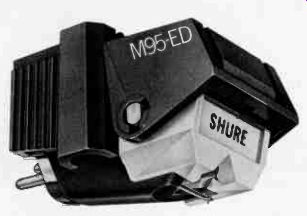
Comment: Shure calls the M-95ED its new No. 2 cartridge, indicating thereby that it has been dropped into the line between the V-15 Type III and the old No. 2 M-91ED ( HF test reports, July 1973 and October 1972, respectively), both of which still are available. Central to the design of the new cartridge is an improved pole piece that offers reduced magnetic losses and improved frequency response by comparison with the M-91ED. In addition, the stylus tip is a nude (that is, mounted directly on the cantilever with out intervening " setting") diamond, which allows a significant reduction of effective tip mass and, consequently, better tracking.
The tracking improvement was readily in evidence during tests at the CBS labs, for a vertical tracking force of only 0.6 gram was needed to pass the " torture test." This compares with 0.8 gram for the M-91ED. With a VTF of 143 grams, which was used for the balance of the tests, the M-95ED exhibited no mistracking, even at the highest groove modulation levels used.
Channel separation is very good, remaining in excess of 20 dB from 20 Hz to well past 10 kHz. Frequency response is without dips and contains just a modest peak in the region of 16 to 17 kHz (confirmed by a slight overshoot and ringing seen atop the 1-kHz square wave), with the right channel a little flatter than the left. The output level of 5.3 millivolts from the left channel and 4.8 from the right should pose no problems for any phono preamp, and harmonic distortion is acceptably low. Lateral inter modulation distortion is somewhat lower than that of the M-91ED at 0.6%, while vertical IM is the same at 3.3%. Inspection of the stylus shows its tip to be well aligned, with good polish and geometry, and reveals a vertical tracking angle of 22 degrees-reasonably close to the nominal 15 degree standard.
The M-95ED is simply a delight to hear: its sound is smooth, clean, and natural and has a solidly anchored stereo image. At high modulation levels there is just a trace of veiled quality that begins to obscure details, but this is noticed ( and just barely) in contrast to the extraordinary clarity at lower levels. The retractable stylus guard is a welcome feature, as is the new body shape, which allows warped records to be played without making contact with the cartridge. Audiophiles, especially those who don't want to spend the extra $ 15 for numero uno, will find Shure's new No. 2, a happy addition to the line.

Square- wave response
Shure M-95ED: Additional Data
Maximum tracking levels ( 1 1/4 grams VTF; re RIAA 0 VU) 300 Hz > + 12 dB 1 kHz +15 dB 10-20 kHz >-5 FREQUENCY RESPONSE
Audio-Technica's Excellent Electret Headset
The Equipment: Audio-Technica AT- 706, an electret condenser stereo headset with impedance-matching/switching adapter unit in metal case. Dimensions: (adapter unit) 3 1/8 by 3 1/8 inches ( front). 7 1/4 inches deep plus clearance for controls and connections. with 5- foot amplifier cable; headphones have 6- foot cable that plugs into adapter. Price: $129.95. Warranty: one year parts and labor, ship ping paid one way. Manufacturer: Audio-Technica, Japan: U.S. distributor: Audio-Technica U.S., Inc., 33 Shiawassee Ave., Fairlawn, Ohio 44313, USA.
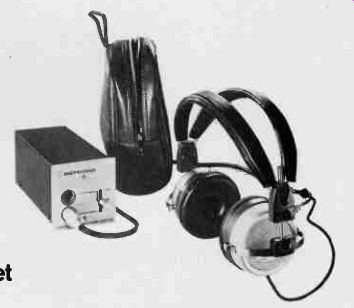
Comment: This design obviously is intended to rival electrostatic headsets, and as such it is a success. Its adapter box resembles those of typical electrostatics, as does its price; its performance in at least one respect outshines that of typical electrostatics.
The adapter box doesn't have quite the function of those used for electrostatics, which derive the necessary polarizing voltage from the audio signal itself ( frequently) or from AC- line voltage ( less frequently). Since the electret elements in the Audio-Technicas are permanently self- polarizing, the adapter box is required only for impedance matching and switching. The leads connected to the adapter are attached to a stereo set of speaker terminals on your amplifier or receiver. We used the REMOTE terminals on most equipment, saving the MAIN terminals for our speakers; if you must pre-empt normally used speaker terminals, you can reconnect the speakers to spring-clip connections (appropriate for bared leads) at the back of the adapter.
The front of the adapter has two European-style sockets, so it will accommodate one or two AT- 706 headsets, whose cords are terminated with the mating plug. Next to the sockets is a three- position lever: LOUDSPEAKERS, STEREOPHONES LOW, and STEREOPHONES HIGH. The first position obviously is used for the speakers connected to the back of
the adapter: the other two positions drive the headset at different levels, with finer level adjustments made at the main system's volume control.
The headset itself is light ( 9 oz.) and has more possible adjustments than most-even the spacing of the two head bands can be varied. It may take you a little longer than usual to adjust the headset to your head, but you should get a better fit when you're done. Even so, we judged the comfort of the unit only average to good (opinions vary). The vinyl ear cushions are quite soft, but they are not as efficient at distributing their pressure as the larger. fluid filled ear cushions on some models, and some users com plain of perspiring ears-a common complaint with head phones.
The seal they offer may be called moderate. Room sounds are attenuated but not severely muffled. The wearer doesn't experience the sense of isolation that some complain of with high- seal sets, but by the same token he can't "shut out" a really noisy environment. He should have a lot to distract him from that environment, however, since the sound quality the AT- 706 presents him with is exceptional: very wide-range and smooth. Fundamental tones stand up very well indeed, with minimum doubling and no audible rolloff. to the neighborhood of 30 Hz. From there up the response is extremely flat to about 8 kHz, where some minor roughness occurs. Response seems to slope off a bit above 10 kHz but holds up well to beyond audibility.
Within this excellent operating range the sound is exceedingly clean and open, with an unforced quality that has none of the " sizzle" or other symptoms of strain that can creep into electrostatics at high levels. When the AT 706 is overdriven (which happens only at very high sound levels- higher than for typical electrostatics, particularly in the bass) the sound acquires what might be described as a mellow buzz that is distinctly less objectionable than the raspy quality we've encountered (again, at lower output levels) with some electrostatics.
If all this interests you but, for practical reasons, you don't want to bother with the adapter- box setup of the AT 706. Audio-Technica offers basically the same transducers and physical design in the less expensive ($ 79.95) AT- 707, which has the matching transformer right in the headset and is driven-via a coiled cord and conventional stereo phone plug-from a normal headphone jack. The straight 6-foot cord between the AT- 706 and the adapter does re strict the wearer's movement somewhat, but the practical advantages of the AT- 707 ( which we did not test) appear to exact a price. Since the matching transformer system built into it must be tinier than that in the AT- 706's adapter, dynamic range and bass response are somewhat restricted by comparison, according to the manufacturer.

In a sense, then, the electret condenser design offers a good deal of the best of two worlds: the extreme frequency range and flatness of electrostatics combined with the dynamic range of good dynamic headsets. Add to this the AT 706's freedom from distortion, and you have an extremely fine stereo headset-one that ( like other extremely fine re producers) may at times afford disconcertingly clear perception of the shortcomings of your system and your recordings, as well as their virtues.
CL-4-Top of KLH's Research Ten Group
The Equipment: KLH Research Ten CL-4, a three-way com pact loudspeaker system in enclosure. Dimensions: 26 13/16 by 14 1/4 inches ( front; can be used vertically or horizontally), 12 13/16 inches deep. Price: $ 189. Warranty: five years parts and labor. Manufacturer: KLH Re search & Development Corp., 30 Cross St., Cambridge, Mass. 02139.

Comment: The KLH CL-4 is the top member of a new line of loudspeakers built with newly designed drivers, cross overs, and enclosure-in short, freshly engineered from the ground up. And, as a ducted- port system, it runs counter to the acoustic- suspension designs that many readers may think of as traditional with KLH. The 10- inch bass driver (given the proprietary name Megaflux Woofer) has a configuration meant to minimize stray fields, to the benefit of both efficiency and linearity.
This crosses over in the region of 500 Hz to a midrange driver housed in a separate aluminum enclosure and de signed to bring forward musical material in its portion of the spectrum. At about 5 kHz the 1- inch dome tweeter takes over, handling the balance of the audio range out to a claimed 22 kHz.
The CL-4 is housed in an enclosure of dense 3/4-inch particleboard faced with an attractive walnut veneer. The brown jersey grille cloth is stretched over a removable frame that is secured to the driver panel with Velcro fasteners. A recess at the back of the enclosure holds a pair of binding posts ( accepting bared wires or spade lugs) for the attachment of leads plus a pair of three- position switches that adjust the levels of the midrange and tweeter, respectively up or down by about 1 dB from their FLAT positions.
Measurements made at the CBS Technology Center indicate that this is a loudspeaker of creditably wide band width. High-end on-axis output is quite flat to about 15 kHz. The woofer response ( measured in an anechoic chamber) holds up well; between the extremes the computer- generated curve is flatter than average. The CL-4 handles power impressively as well. A sound pressure level of 100 dB is reached at 80 Hz with only moderate distortion for this output at so low a frequency. At 300 Hz the unit accepts 100 watts, for almost 108 dB of output, be fore distortion becomes excessive. Pulses to 168 watts average (336 watts peak), the limit of the test amplifier with this speaker, produce an output level of almost 113 dB without excessive distortion.
This bespeaks excellent dynamic range. KLH recommends amplifiers of 25 watts or more, which the tests show will drive the system to upward of 100 dB. The lab found 3.2 watts necessary to drive it to our standard test level of 94 dB ( at 1 meter on axis), which represents moderate efficiency. KLH rates power handling at 200 watts continuous, and impedance at 8 ohms. Actually the impedance, as measured at the lab, never drops below about 9 ohms. Its rating point ( the minimum just above bass resonance-at about 55 Hz) is 10.7 ohms in the neighbor hood of 100 Hz. It rises to a little beyond 16 ohms in the midrange, then gently falls again. Obviously this is not a speaker with which one need worry about parallel hookups across typical transistor amplifiers.
In listening tests we found the bass to hold up very well, with little doubling, to about 35 Hz. Highs are excellently dispersed; the first hint of beaming can be detected at about 13 kHz, but test tones are readily audible off axis to about 15 kHz. White- noise reproduction has a little less body than that of some speakers, perhaps, and is brighter than average. But we found that the speaker is somewhat more sensitive than average to the type of room in which it is used.
It produces a rather forward sound-presumably what KLH is referring to when it says in the advertising folder: "Much of the music that is lost, 'laid back,' or muffled in other speakers is brought forward and into proper musical focus by the CL-4's cone midrange." The sound seems to come from just in front of the speaker when only one is used ( in mono) for A/ B comparison with other models.
This makes for a tight stereo image with, perhaps, less depth than might be injected into it. It is more of a close-up perspective than one usually encounters. In smaller listening rooms, in fact, some listeners may prefer a more "laid back" sound. Certainly the balance and over-all sound strike us as more attractive when the system has a reasonably large space to work into.
There was a time when a truism of loudspeaker design accepted at KLH no less than elsewhere-was that nobody can stand a flat loudspeaker. The contention was that a flat high end puts the listener as " unnaturally" close to the musicians as the microphones are during the recording session. This is an oversimplification of the argument, of course; the point is that the CL-4 turns its back on that argument as do many other recent speakers that are de signed for a relatively flat high end. This is a more significant break with KLH tradition than the use of a ported bass enclosure ( which the company has used in past models) and documents KLH's awareness that, as it says in a Research Ten brochure, " times and technology do change."
----------------
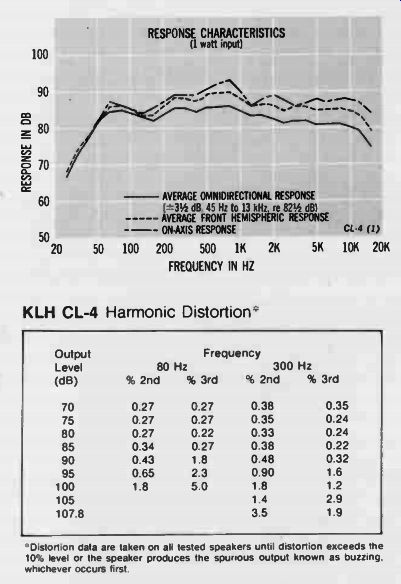

RESPONSE CHARACTERISTICS (1 watt input)
AVERAGE OMNIDIRECTIONAL RESPONSE
AVERAGE FRONT HEMISPHERIC RESPONSE
ON-AXIS RESPONSE
FREQUENCY IN HZ
KLH CL-4 Harmonic Distortion' Output Frequency Level 80 Hz 300 Hz
Distortion data are taken on all tested speakers until distortion exceeds the 10% level or the speaker produces the spurious output known as buzzing, whichever occurs first.
Thorens Model TD- 145C Turntable -- Thorens Goes (Semi) Automatic
The Equipment: Thorens Model TD- 145C, an automated single- play two- speed (33 and 45) turntable with integrated tone arm, wood base, and dust cover. Dimensions: 17 by 13 1/2 inches ( base); 7 3/4 inches high with dust cover closed, 15 1/2 inches fully open. Price: $299.95. Warranty: one year parts and labor.
Manufacturer: Thorens, Switzer land; U.S. distributor: Elpa Marketing Industries, Inc., Thorens & Atlantic Aves., New Hyde Park, N.Y. 11040. Comment: Thorens has, perhaps, the longest history of any company in the home music-reproduction field, stretching back to music-box days and including some of the finest early spring- wind disc turntables. Over the past twenty years or so, it has produced what must be reckoned the world's most consistently prestigious line of manual single- play turntables. And now it has gone automatic with a single- play unit that is distinctly individual yet distinctly Thorens.
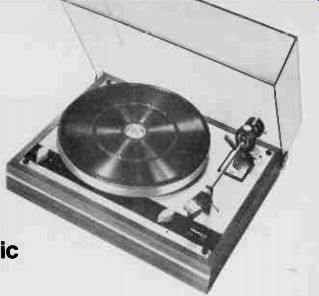
The obvious automatic feature of the TD- 145C is in its arm liftoff. It is activated electronically by any relatively rapid motion of the tone arm-whether because it has reached the leadout groove or because a fumble- fingered owner has let the finger-hold slip from his grasp. It will not be tripped by the spiral between cuts on an LP, but it will be tripped by the attempt to skip manually to a cut near the end of an LP. And herein lies our only complaint about the turntable. Having to restart it repeatedly can get to you when you're hunting about for a specific passage in the music. An automation-defeat option for this purpose would have been nice.
This consideration aside, the operation is silky smooth.
A positive press of the left-hand " knob" toward either 33 or 45 starts the platter; moving the right-hand knob to the right lowers the arm gently and begins play. This latter knob can be used for cueing at any point. If arm travel speeds up or, for any reason, the power is cut off, the platter stops (though the left-hand knob does not flip back to its center STO P position), the arm raises, and the right hand knob moves to the left ( arm up) position. To recommence play, you just nudge the left knob toward its extreme position once again and switch the cueing knob. The cue feature operates with no side drift.
The dynamically balanced nonmagnetic die-cast platter weighs in at 4 1/2 pounds. ( Actually the entire " flywheel" includes the large metal pulley on which the platter rests; Elpa rates the assembly at 7 pounds.) Its rubber surface mat has a special " indented" treatment intended to pre vent trapped air pockets beneath the disc from creating resonance effects during play. In the center is a reversible spindle; when you switch from LPs to large-hole 45s you simply flip over this insert.

The motor is a 16-pole synchronous design coupled to the pulley beneath the platter by a belt. The system comes up to speed very rapidly (1 1/2 seconds is Thorens' spec) and is very rumble-free: -59 dB was measured by the lab using the ARLL method. There is no speed "tuning" control. At 33 rpm the unit checks out 0.2% fast at all test line volt ages; at 45 it is 0.14% fast and again does not vary with line voltage. Weighted average peak flutter measures 0.07% with maximum instantaneous values of 0.14%. These figures all are squarely within the ballpark for to day's top turntables and represent essentially undetectable departures from "perfect" performance.
The integrated TP-16 tone arm has an interchangeable low-mass head shell at the end of a straight tubular arm. Balance and VTF are adjusted at the counterweight system at the back of the arm. ( The accuracy of the VTF settings is shown in the Additional Data table.) To the right of the pivot is the adjustment for antiskating: A knob with two scales ( for spherical and elliptical styli, respectively) controls a magnetic biasing system. Both scales produce antiskating forces slightly below those typically encountered but well within the range that theory predicts as desirable.
Arm friction is negligible both horizontally and vertically. Thorens claims less than 20 milligrams, and the lab found it too low for useful measurement. With the Shure V-15 Type III cartridge, arm resonance measures a moderate 4 dB at 8.5 Hz. The arm lift system introduces no drag, of course, because it involves no physical coupling to the arm.
The arm mount and platter bearing are isolated from both external vibration sources (shock and feedback) and motor vibration by the mounting system. The controls are mounted on the same assembly as the motor so that their operation does not transmit motion to the arm and plat ter. This system, we find, works very well indeed and con tributes to the surefooted precision with which the TD 145C fulfills its appointed functions. This is what the unit is about; automation or no, it is every inch a Thorens.
----------- Thorens TD-145C Additional Data: Tracking-force gauge accuracy ( grams)
Radio Shack's Top 4/2-Channel Receiver
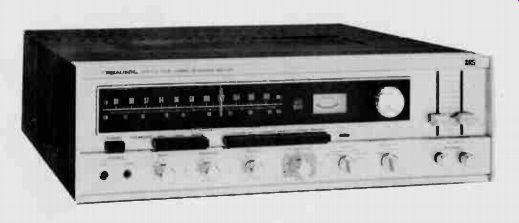
The Equipment: Realistic Model QTA-770, an AM/FM receiver with four-channel amplifier and optional higher power two-channel mode, CD-4 demodulator, and SQ matrix decoder; in wood case. Dimensions: 19.5 by 6 inches (front panel); 13.5 inches deep plus clearance for controls and connections. Price: $ 599.95. Warranty: one year parts and labor. Manufacturer: Radio Shack, 2617 Seventh St., Fort Worth, Tex. 76107.
Comment: The Realistic QTA-770 is equipped with an al most dazzling array of controls and conveniences, at least one of which (the AUDIOROTOR, which shifts the four-channel sound field so that center front is midway between any adjacent pair of speakers) is rarely seen. The neatly styled front panel features a slide- rule FM dial with a pointer that glows red when the receiver is tuned to a station transmitting in stereo. To the right of the dial are a signal strength meter and a large tuning knob. Slider controls- arranged so that both can be operated with one finger- that adjust the volume of the front and back channels, respectively, lie at the extreme right of the panel.
Below the dial is a row of pushbuttons. First come POWER and MAIN and REMOTE speakers, allowing selection of either, both, or neither of two sets. (The manufacturer cautions that, while the receiver can drive 4-ohm speakers, two sets of these should not be connected at once, nor should STEREOMAX or QUATRAVOX be engaged with 4-ohm speakers connected.) The six remaining buttons control high- and low-cut filters, loudness compensation, FM muting, AUTOMAGIC (AFC), and tape monitor.
The bottom of the front panel has stereo headphone jacks for both front and back channels; tone controls for bass, midrange, and treble; the AUDIOROTOR control: a mode switch that chooses among DISCRETE 4, MATRIX SQ, QUATRAVOX (a synthesizer that derives four channels from ordinary two-channel material), STEREO, STEREOMAX (a strapped mode with power fed to the front channels only), and MONO; and a selector for AM, FM, PHONO/CD-4, or AUX. Knobs at the extreme right adjust the left- right balance of the front and back channels.
A pair of convenience outlets (200 watts unswitched, 100 watts switched), a fuse, and the AC power-line cord are in the far left section of the back panel. The center portion holds binding posts for two sets of loudspeakers, with pin-jack outputs provided for the main set as well. To the right is an array of pin jacks: one quadriphonic set for tape output, one for detector output (allowing for a future adapter for discrete four-channel broadcasts), quadriphonic sets for tape input and for aux input, and a two channel set for magnetic phono input. The sensitivity of the phono input (0.8 or 1.6 millivolts) can be raised or lowered via a switch below the jacks, and nearby are the separation controls for the CD-4 demodulator. At the lower right corner are a binding post for phono ground and screw terminals for an AM antenna and a 300- or 75-ohm FM antenna. A rod antenna for AM is also provided.
CBS Technology Center tested the amplifier section in the strapped mode ( STEREOMAX) at the 66-watt- per-channel rating given in the instruction manual. This specification is met at midband ( 1 to 4 kHz), but there is a consider able rise in harmonic distortion toward the frequency extremes-particularly in the right channel. In a more re cent catalogue Radio Shack has chosen a more conservative rating ( perhaps to comply with FTC rating rules) of 60 watts per channel, and the lab data suggest that the unit in fact meets this at less than 1% THD across the audio spectrum. No untoward amplifier behavior was detected in listening. In the four-channel mode (rated at 25 watts per channel for less than 1% THD, 20 Hz to 20 kHz), which we used for most listening tests, the audio from the loud speakers seemed crisp and clean.
The preamp is, by and large, a fitting complement for the amplifier section. The SQ decoder-of the simple matrix type without logic- provides surprisingly good localization. There is a perceptible rolloff toward the bass region, attributable in part to the droop visible in the RIAA response curve (we were listening to discs), but here the flexibility provided by the three-way tone controls came nicely to the rescue. The midrange control in particular keeps soloists, especially in pops, out of the general vicinity of one's lap. The CD-4 demodulator has the same frequency-response imbalance (and the same remedy applies) and is somewhat sensitive to disturbances caused by less than perfect record surfaces. Contrary to the implications of the manual setup instructions, it is possible for a CD-4 pickup to overload the phono input; we suggest set ting the phono sensitivity switch for best sound. The QUATRAVOX works well in synthesizing quadriphonic sound from two-channel sources, but, as the instructions suggest, the SQ decoder may produce a better quadriphonic effect with some stereo program material.
--------------
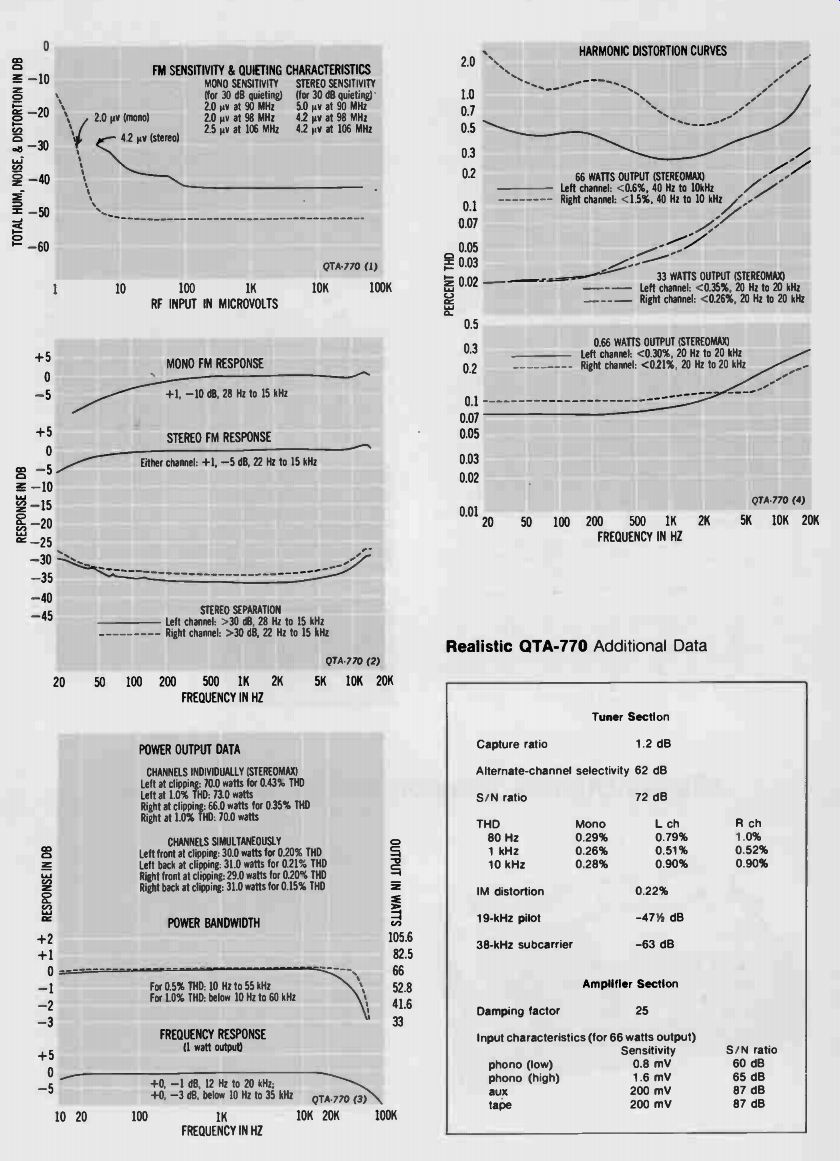
FM SENSITIVITY & QUIETING CHARACTERISTICS
HARMONIC DISTORTION CURVES POWER OUTPUT DATA CHANNELS INDIVIDUALLY (STEREOMAX)
Realistic QTA-770 Additional Data
Tuner Section Capture ratio 1.2 dB Alternate-channel selectivity 62 dB
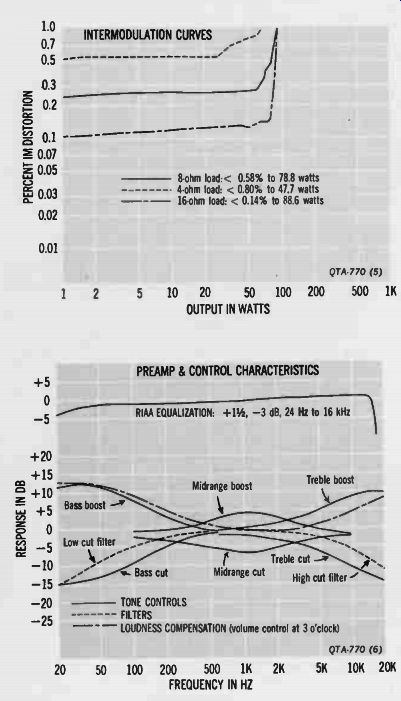
----------- INTERMODULATION CURVES ; PREAMP & CONTROL CHARACTERISTICS
The FM section of the QTA-770 performs quite adequately except under the most difficult reception conditions. The ultimate mono quieting figure of 52 1/2 dB is reached at only 15 microvolts' input. Ultimate stereo quieting, 43 dB, is reached at 250 microvolts, which is still a rather modest signal level. Tuning is assisted only by a signal-strength meter. To prevent drift (which is more difficult to compensate for without a channel-center meter, of course) you can switch in the AUTOMAGIC, which disengages automatically when the tuning knob is touched and re-en gages upon its release. The signal meter lights up green whenever this AFC switch is on; otherwise it is white. Once again, the tone controls are of benefit in improving frequency response of both stereo and mono FM. Considering the QTA-770 as a whole, one finds that the sections are well matched, with no one part materially out performing or underperforming the others. When its cornucopia of controls and devices is taken into account, its price seems quite modest. It is not a super- spec job by any standards, and some readers surely would prefer to trade some of the front- panel features for a little more in the way of pure performance. But without the QTA-770's "extras" the unit would be much less fun to work with.

---- Square-wave response
Hitachi Offers a Monitor-Head Cassette Deck
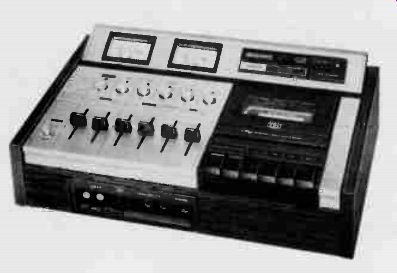
The Equipment: Hitachi Model D-3500, a stereo cassette deck with monitoring capability, in wood case. Dimensions: 16 3/4 by 10 3/4 ( plus clearance for cables) by 5 1/2 inches. Price: $399.95. Warranty: three years parts and labor except on motor, heads, and rubber belts; five years on transistors. Manufacturer: Hitachi, Japan; U.S. distributor: Hitachi Sales Corp. of America, 48-50 34th St., Long Island City, N.Y. 11101.
Comment: Hitachi uses the phrase " three- head system" in much the way that Wollensak has-to indicate the functional head complement rather than the number of head housings. There are, in fact, only two in the cassette well of the D-3500: the erase head (which fits into the tiny opening between the left " window" where most erase heads are placed and the center one where the record / play head goes) and a record and play head that actually is two heads (and sets of head gaps) within a single housing.
This is an important point in the design, we believe.
Most companies offering monitoring-head units ( Hitachi included) point to the greater high-frequency response available with this sort of design as opposed to combination record/play heads. Technics, on the other hand, has recommended that its separate cassette play-only head (as offered in the RS-279US, HF test reports, February 1974) be used just for monitoring purposes; its recording head is used for normal playback. Why give up the extra response? For one thing, because of tape skew.
Cassette tapes are both thin and narrow. They can easily twist as they wend their way from one head to another, putting a premium on the way they are supported between heads if the gap-to-tape alignment recorded at one is to be reproduced correctly at the other and hence the full frequency range is to be realized with correct phase relation ships between channels. With a single record/play head the tape may skew, but it tends to skew the same way each time it passes the head, reproducing what it records within close tolerances. The Hitachi dual-purpose head, by get ting recording and playback gaps very close together, offers something of the best of both designs.
The cassette well has one particularly nice touch: A spring- loaded panel in the near edge swings up for easy ac cess in cleaning and head-demagnetization. In front of the well are the usual control levers, which allow you to go directly from play (or recording) into a fast-wind mode or back and forth between fast-wind modes, but not back to play, without first pressing STOP. The latter button also is the EJECT. When the transport is in operation, this button will only stop it; when it is stopped, a second press will eject the cassette. PLAY and RECORD buttons are side by side.
The transport can be put into the recording mode-accidentally if you're very careless-with a single finger. There is automatic shutoff of the transport at the end of the tape.
To the left, in front of the meters, is a series of large pushbuttons. Their settings are hard to " read" at a glance, so Hitachi has provided each with a pilot light.
There are buttons for MONITOR (SOURCE/TAPE), INPUT (LINE/MIX, the latter combining line feed with mike inputs via their respective sliders), DOLBY, TAPE (DRO.,/ NORMAL), MEMORY ( for automatic stop at the counter's 000 setting in rewind), and METER action ( PEAK /averaging VU). The latter option is welcome. Frankly, we prefer peak-reading meters, but the switch will satisfy users on both sides of this ideological fence. The tape switching can be overridden by an automatic chrome sensor in the tape well; if it finds the chrome keyway (a little well next to the recording tab), it will switch the deck to CHROME even if you have it manually switched to NORMAL--which, of course, is the ferric bias/ equalization position.
In front of these switches are three pairs (one per channel) of sliders for controlling level in the mic / DIN input, the LINE input, and the output. LINE IN and LINE OUT connections are pin-jack pairs on the back panel; on the same panel are the DIN input/output socket and an on/off pushbutton for the output ( killing it to prevent feedback when you are recording with mikes). The mike inputs are phone jacks in a recessed panel at the front of the deck. If you insert a mike plug into the left- channel jack only, it feeds both channels; adding one in the right-channel jack automatically converts to stereo. This is a useful wiring scheme that, while not unique, is less common than we would either like or expect.
To the left of these jacks are an MPX ( filter) on/off but ton (to prevent the FM pilot from upsetting Dolby behavior), a spring- loaded TEST button (an oscillator for use in adjusting Dolby levels to the sensitivity of your tape), and two small knobs for the same purpose. For the careful recordist this, too, is a welcome feature. And note that the monitor head obviates the cumbersome cut- and-try adjustment necessary with a combination record/play head.
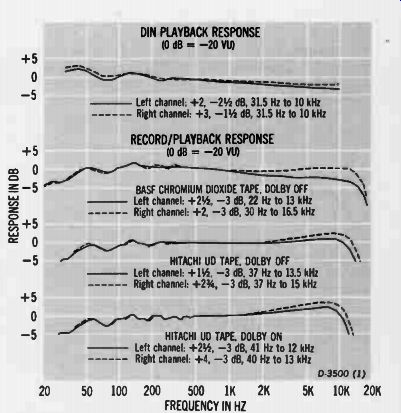
----------- Hitachi D-3500 Additional Data ; DIN PLAYBACK RESPONSE
In measuring the unit, CBS used UD tape supplied by Hitachi as the ferric, BASF Chromdioxid as the chrome. The response curves do not extend as high as those of some (very expensive) monitor- head cassette decks; they resemble, rather, those we might expect in a $400 deck with a combination head. The curves made with UD have a rise toward the high end, suggesting under-biasing. And when we tried the deck with a tape requiring slightly lower bias (Memorex MRX,) we found an excellent match between source and recorded sound. That is, we could hear no loss of highs attributable to the high-end rolloff ( nor would we really expect to), and we could hear an improvement by comparison with the slight treble emphasis with UD. The sound is, in fact, excellent.
So is motional stability: As the lab data show, there is no change in speed with varied line voltage and very low wow and flutter. This speaks of good mechanical design in the drive system. (Our only real complaint was occasioned by the automatic bias/equalization microswitch. On our sample, it has excessive clearance and consequently switches to CHROME when it should stay in NORMAL. We would rather see the automatic feature omitted than risk this. And a minor inconvenience: a latch on the cassette well lid that seats poorly on our sample, causing wear and an increasing tendency to pop open or not to latch at all. Both malfunctions could easily be prevented by minor re-design, and Hitachi--to whose attention we brought them-says it plans to do so for the first full-scale production run, which had not begun when our tests were con ducted. The deck basically is far too good to be compromised by such details.) Overall, the deck offers a heck of a lot for $400. We particularly like its ability to monitor the quality of recordings right off the tapes while you're making them. The accessibility of the Dolby adjustments and the availability of peak metering also are important points for serious recordists, as are the mixing feature and the simplicity of using a single mono mike (particularly when mixing its output with stereo on the line feed). Dual ferric tape switching, to pro vide a closer match to the " hotter" tapes like UD as well as a good match to the Memorex and similar formulations, might have been nice. But even without it the D-3500 is an unusually versatile and useful deck.
SAE's Glamorous Mk. VI-B Tuner

The Equipment: SAE Mk. VI- B, a stereo FM tuner with digital readout. Dimensions: 17 by 5 3/4 inches (front panel); 10 1/2 inches deep plus allowance for controls and connections. Price: $ 1,250; optional Model WC-1 wood case, $44. Warranty: 90 days parts and labor; free five-year service contract. Manufacturer: Scientific Audio Electronics, Inc., P.O. Box 60271, Terminal Annex, Los Angeles, Calif. 90060.
Comment: This is SAE's super-tuner, and we originally had planned to include it in last month's multi-model roundup. The vagaries of transcontinental carriers prevented that, but the unit should be understood in that context. As we said of other models at that time, it is so good that comparative criticisms are, to a considerable extent, a question of nit-picking.
The front panel of the SAE Mk. VI- B, with its gold anodized surface and knobs, is impressive indeed. The upper section is dominated by a long, rectangular smoked plastic window that embraces a large tuning knob toward its right flank and a cluster of four small plastic knobs (to control position, brightness, and focus of the oscilloscope display) to the left. When the power is first turned on the digital readout lights up almost magically ( because it is virtually invisible with the power off) in the center of the window.
This is followed in a few seconds by a scope display at the extreme left of the window.
Just to the right of the digit display (which, reflecting FCC channel assignments, shows only odd numbers after the decimal point) there are red and yellow lights stacked vertically-red for stereo reception, yellow for mono.
Across the lower part of the panel are more knobs and pushbutton switches, plus a stereo phone jack for output to a tape recorder. The first knob on the left ( SELECTOR) chooses among mono, AUTO, and STEREO; the second ( DIS PLAY) switches the oscilloscope among FM, AUDIO, and EX TERNAL. The first pushbutton, marked EXTERNAL, controls the sensitivity ( HIGH or Low) of those inputs to the scope.
The next, the POWER switch, turns the unit on or off, and the last is MUTING (ON/OFF). The next knob is a continuously variable muting-threshold control; the last is a five position stepped audio- output level control designed for 6- dB differences between adjoining steps.
In contrast to the front panel, the back panel is stark in its simplicity, containing screw- knob inputs for bared or spade- lug 300-ohm and 75- ohm antennas, two stereo output pin-jack pairs (one of which bypasses the front panel output level control), input pin jacks ( the external oscilloscope input), and a detector output jack ( to allow use of an adapter if and when a four-channel broadcast standard is approved). Further to the right are a fuse and the AC line cord.
Tuning is continuous and by means of a knob; only the channel readout is digital. In this respect, the Mk. VI- B compares with such tuners as the Sequerra Model 1, rather than models that ( like the Heath AF- 1 51 0A) use essentially digital frequency- synthesis techniques for the tuning itself. The readout does not indicate accuracy of tuning; the scope display is meant to do this-as well as to identify multipath and to indicate signal strength and modulation level.
We didn't find this tuning scope as easy to use as some we've worked with, however. In our sample the tuning display is offset somewhat to the right in relation to the audio displays (the Lissajous or X-Y display of left and right channel program content-which is a particularly useful feature of any scope- equipped unit). Consequently, when the display is centered according to the manual's instructions (using the external- audio mode with no input to get a stationary trace) the tuning display does not line up with the calibration marks. This makes tuning of a station whose modulation level is low at the moment of tuning rather problematical. Though our tuning expertise in this situation improved with familiarity, it did not equal that possible with a channel- center meter. But the scope does yield much more information ( peculiarities of multipath, station modulation levels, and so on-to say nothing of the audio display) than meters, so the comparison is not entirely apt.
There is one particularly intriguing operating feature: a capacitance switch that flips the scope display from AUDIO (if the DISPLAY selector is set there) to FM ( that is, the tuning-multipath display) when the tuning knob is touched, thus saving a step in tuning. A moment after your hand leaves the knob, the scope automatically reverts to audio display. Other nice touches include the heavier spring load on the POWER button ( which helps you avoid turning the unit off by mistake) and the fact that the scope trace dims when it is stationary for more than an instant ( to avoid burning the phosphor screen). The astounding alternate- channel selectivity figure ( better than 120 dB) measured by the CBS lab is the best we have seen. It suggests that tuning might also be exception ally easy with stations on adjacent channels, but in practice this is not the case. Other tuners we have tested do as well or better in this respect-though adjacent- channel spacings are encountered less often than alternate-channel in today's typical ( i.e., urban or suburban) life style.
Mono quieting reaches a very good 54 1/2 dB at only 15 microvolts' input, but the best attained by our sample at any signal level is 56 dB. Stereo quieting reaches a highly respectable 55 dB, but that performance level requires 1,000 microvolts or more at the antenna terminals. Frequency response is superb in mono but falls off slightly at the top end in stereo, reaching -3 dB at 15 kHz. The unit measures-and listens-well in terms of both channel separation and distortion.
We must repeat that our reservations about the Mk. VI- B must be understood in the light of exacting comparisons among super-tuners. It is a fine unit and an exceptionally handsome one.
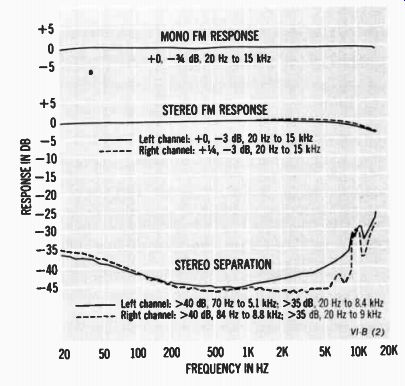
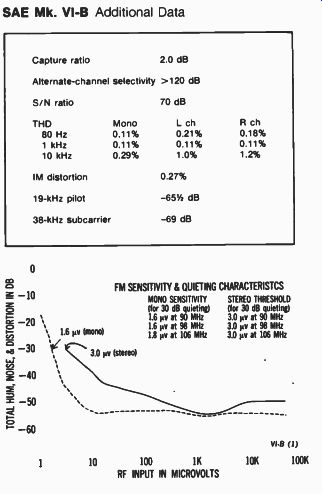
------- MONO FM RESPONSE SAE Mk. VI- B Additional Data: FM SENSITIVITY & QUIETING
CHARACTERISTCS
-------------
(High Fidelity, Jan. 1976)
Also see:
Onkyo A-7 Integrated Amp (Equip. Profile, Nov. 1977)
Sergiu Celibidache (Jan. 1976)